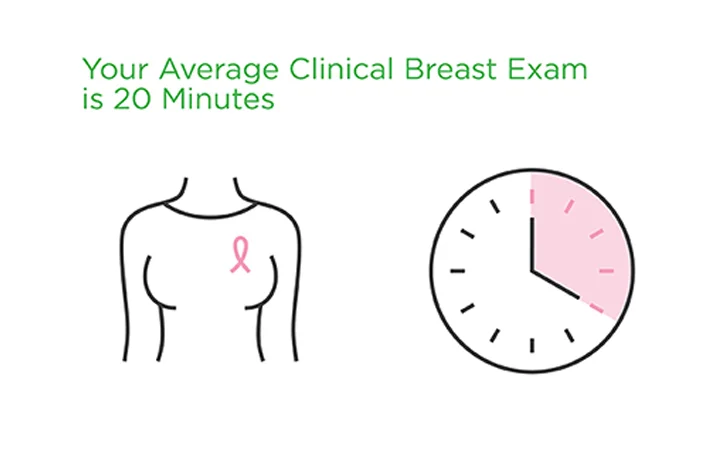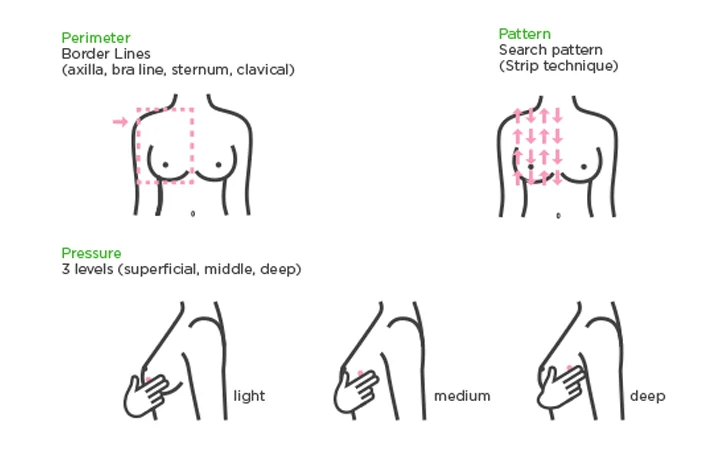I’m in my 20s
In your 20s, mammograms likely aren’t on your radar, but getting to know your breasts should be a top priority for your breast health. The younger you are, the lumpier and thicker your breast tissue is likely to be.
Learn what actions you can take now in your 20s for your breast health by choosing from the personalized tips below.
Know preventative care guidelines
Now is the time to develop healthy exercise and eating habits. As you age, obesity increases your risk of developing breast cancer. It will be easier to shed any extra pounds now than it will be in your 30s and 40s.
The National Comprehensive Cancer Network suggests women in their 20s have a clinical breast exam every one to three years. This hands-on exam performed by a trained provider will give you invaluable knowledge about your unique breasts. The visit should also include family and personal health and cancer history to determine your risk.
Know mammograms
In your 20s, it’s unlikely you will have a mammogram. But it is important to know this low-radiation X-ray of the breast is a key tool at looking into the breast tissue. There are two types:
- Screening mammograms: X-ray taken at a few different angles that look for signs of cancer. Performed for women who have no breast cancer symptoms.
- Diagnostic mammograms: X-ray that can provide magnification views of breast tissue. Performed for women who have a sign of breast issue such as breast pain in a specific area, nipple discharge or a lump.
It is more likely at your age a breast problem will be investigated first with an ultrasound, then possibly followed by a mammogram at the radiologist’s recommendation.
Know breast pain
The most common breast pain or tenderness is caused by hormone shifts during your menstrual cycle. Other culprits of breast pain can be:
- Bra: An unsupportive or too tight-fitting bra can cause breast aches and pains.
- Pregnancy: Swollen, achy breasts are often the first signs of pregnancy due to hormone changes.
- Breastfeeding: If a milk duct becomes blocked, you could experience a painful infection called mastitis.
- Exercise: Running and upper body exercises can make the muscles behind your breast sore.
- Caffeine: Overuse or high intake of caffeine causes the blood vessels to dilate, which can make breasts swell and feel painful.
Breast cancer doesn't typically present as pain or pain in both breasts. If you feel a lump, you might keep an eye on it through one menstrual cycle. If it goes away, it was probably caused by hormone shifts. If it doesn't go away, have it checked out.
Know clinical breast exams

Early detection is important when it comes to surviving breast cancer. The National Comprehensive Cancer Network suggests women in their 20s have a clinical breast exam (CBE) every one to three years. A screening mammogram is usually not recommended until your 40s.
This hands-on clinical breast exam is performed by a trained provider and can identify some cancers undetected by mammography. There are some questions you should ask your provider about a breast change:
- How can I tell the difference between my usual lumps and lumps I need to do something about?
- How will you be able to tell what kind of breast change I have?
- What should we do to watch this change over time?
The visit should also include family and personal health and cancer history to determine your risk.
Know your breast

In your 20s, your breasts are fully developed, but the appearance and feel can change around the time of your period or during pregnancy or weight gain.
Take the time for breast awareness and follow the three Ps:
- Perimeter: Using the pads of your middle three fingers, trace from your collarbone to your armpit, down the outside of your breast, underneath and then back up to your collarbone again.
- Pattern: Beginning under your arm, move your fingers in straight vertical lines over your breasts.
- Pressure: Move the pads of your fingers in small, dime-size circles over your breast tissue and underarms, using light, medium and deep pressure.
Take note of discharge from your nipples and itchy, red or scaly skin. If you find a rock-like lump, call your physician. If you find soft lump, keep track of it. If it doesn't go away after your next period, call your doctor. Eighty percent of lumps biopsied are not cancerous. But any new, persistent lump should be evaluated.
Know risk factors
The more you know about your body and your family history, the more empowered you are to determine your breast cancer risk. Age plays a significant role, but that risk is relatively low when you are in your 20s. Other breast cancer risks include:
- Genetic risk: When genetic defects are passed down in your genes from your parents.
- Familial risk: Cancer has been diagnosed in your family but it might be linked to environmental or lifestyle factors, not your genes.
- Personal risk: Unique to you modifiable risks, such as alcohol consumption, lack of exercise, smoking, unhealthy diet, and non-modifiable risks, such as breast density, late menopause and previous radiation therapy of the chest wall.
Get to know your family history by asking questions such as who had cancer, what type of cancer and the age they were diagnosed. Share this information with your health care provider.
Know your genes
Approximately 10 to 15% of all breast cancers are inherited. This makes knowing your family history key to understanding your risk.
Genetic mutations can be passed down. Science has shown a BRCA mutation is the single, biggest risk factor for breast cancer. If your family medical history includes any of the following, you may want to consider genetic counseling and testing:
- Are you a female who was diagnosed with breast cancer before the age of 50?
- Are you a male who was diagnosed with breast cancer or have a close male relative who was diagnosed with breast cancer?
- Do you have a mother, sister, daughter, grandmother or aunt who had breast cancer before age 50 or ovarian cancer at any age?
- Do you have three relatives on the same side of the family who were diagnosed with breast cancer at any age?
